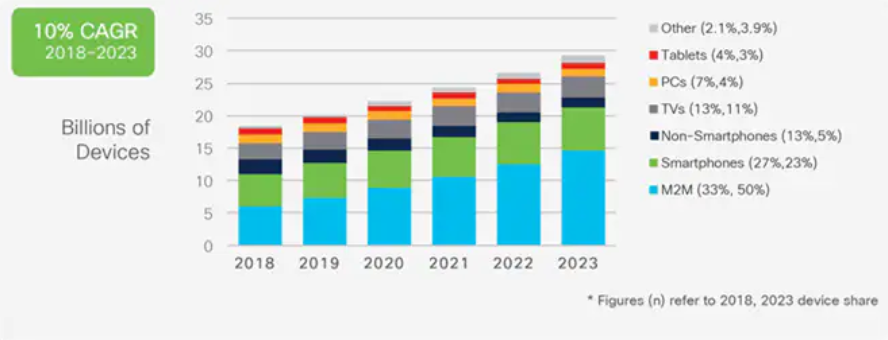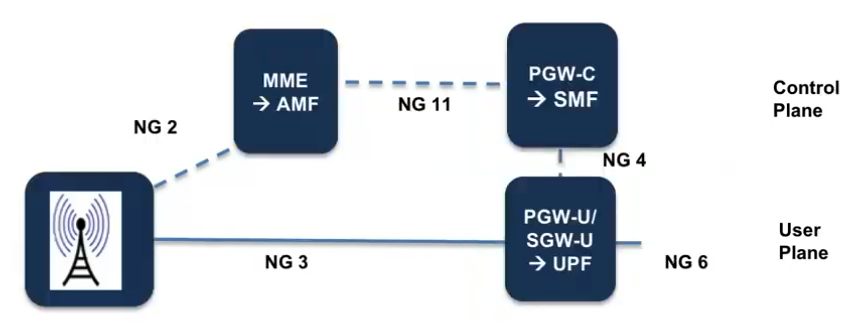What is CUPS?
CUPS stands for Control and User Plane Separation of Evolved Packet Core (EPC) nodes and provides the architecture enhancements for the separation of functionality in the Evolved Packet Core’s Serving Gateway (SGW), PDN gateway (PGW), and Traffic Detection Function (TDF).
This enables flexible network deployment and operation, by distributed or centralized deployment and the independent scaling between control plane and user plane functions – while not affecting the functionality of the existing nodes subject to this split.
Motivation for CUPS?
Many mobile operators’ user data traffic has been doubling on an annual basis in recent years. As per CISCO Annual Internet report Globally, the average number of devices and connections per capita will grow from 2.4 in 2018 to 3.6 by 2023.

Source: CISCO
The reasons for this growth in traffic are the rapidly increasing use of smart devices, the proliferation of video and other applications that they support, and the use of USB modem dongles & personal hotspots using 3GPP networks.
As the penetration of these terminals increases worldwide and the interest in content-rich multi-media services (e.g. OTT video streaming services, Person to person video, content sharing) rises, this trend of rapidly increasing data traffic is expected to continue and accelerate. At the same time, there is strong consumer demand for user experience improvements, with lower latency being one of the critical KPIs to be met on the way.
So lets before How CUPS can help in this, let’s see the implementation concept in the Core network.
CUPS Architecture principles for 4G Network
Control and User Plane Separation of EPC nodes (CUPS) is one of the main Work Items of 3GPP Release 14. CUPS separate control & user plane from S-GW, P-GW & TDF. TDF is Traffic Detection Function that was introduced together with the Sd reference point as means for traffic management in Release 11. Traffic Detection Function (TDF) is a network function that enforces traffic policies in real-time based on either pre-set rules or rules determined dynamically by the policy control rules function (PCRF) engine.
CUPS introduces 3 new interfaces, Sxa, Sxb and Sxc between the CP and UP functions of the SGW, PGW, and TDF respectively.

CUPS Architecture
The following high-level principles were adopted:
- The CP function terminates the Control Plane protocols: GTP-C, Diameter (Gx, Gy, Gz).
- A CP function can interface with multiple UP functions, and a UP function can be shared by multiple CP functions.
- A UE is served by a single SGW-CP but multiple SGW-UPs can be selected for different PDN connections. A user plane data packet may traverse multiple UP functions.
- The CP function controls the processing of the packets in the UP function by provisioning a set of rules in Sx sessions, i.e. Packet Detection Rules for packets inspection, Forwarding Action Rules for packets handling (e.g. forward, duplicate, buffer, drop), Qos Enforcement Rules to enforce QoS policing on the packets, Usage Reporting Rules for measuring the traffic usage.
- All the 3GPP features impacting the UP function (PCC, Charging, Lawful Interception, etc) are supported, while the UP function is designed as much as possible 3GPP agnostic. For example, the UPF is not aware of the bearer concept.
- Charging and Usage Monitoring are supported by instructing the UP function to measure and report traffic usage, using Usage Reporting Rule(s). No impact is expected to OFCS, Online Charging System (OCS), and the PCRF.
- A legacy SGW, PGW, and TDF can be replaced by a split node without affecting connected legacy nodes.
CUPS Architecture Advantages & Efficiency
- Reducing Latency on application service, e.g. by selecting User plane nodes that are closer to the RAN or more appropriate for the intended UE usage type without increasing the number of control plane nodes.
- Supporting Increase of Data Traffic, by enabling to add of user plane nodes without changing the number of SGW-C, PGW-C, and TDF-C in the network.
- Locating and Scaling the CP and UP resources of the EPC nodes independently.
- Locating, Scaling, and evolution of Control Plane and User Plane resources are done independently
- Enabling Software Defined Networking to deliver user plane data more efficiently.
CUPS in 5G Network
CUPS is essential to 5G networks because it allows operators to separate the evolved packet core (EPC) into a control plane that can sit in a centralized location and for the user plane to be placed closer to the application it is supporting.

CUPS in 5G Network
This type of separation is key for applications such as the connected car. In that scenario, a network operator can place the EPC user plane in a data center in a city so that it is closer to the application and therefore reduces the latency.
Conclusion
The Evolved Packet Core (EPC) network is evolving and moving toward Control User Plane Separation (CUPS) based architecture where User Plane and Control Plane are separate nodes for P-GW, S-GW, and TDF products.
The User Plane and Control Plane combined to provide the functionality of a node for other elements in the EPC network. However, keeping it separate has numerous advantages from the network point of view – support different scaling for Control Plane and User Plane, support more capacity per session-level in User Plane, and so on.
References:
- 3GPP, Control and User Plane Separation of EPC nodes (CUPS).
- 3GPP, Interface between the Control Plane and the User Plane nodes (3GPP TS 29.244 version 16.9.1 Release 16).
- Architecture enhancements for control and user plane separation of EPC nodes (3GPP TS 23.214 version 16.2.0 Release 16)













